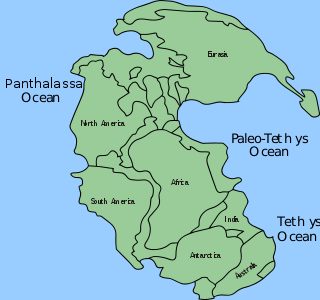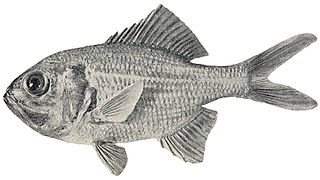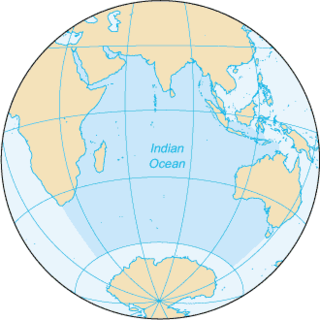
The Atlantic Ocean is the second largest of the world's oceans, with an area of about 106,460,000 square kilometers. It covers approximately 20 percent of the Earth's surface and about 29 percent of its water surface area. It separates the "Old World" from the "New World".

The Pacific Ocean is the largest and deepest of Earth's oceanic divisions. It extends from the Arctic Ocean in the north to the Southern Ocean in the south and is bounded by Asia and Australia in the west and the Americas in the east.

Monsoon is traditionally defined as a seasonal reversing wind accompanied by corresponding changes in precipitation, but is now used to describe seasonal changes in atmospheric circulation and precipitation associated with the asymmetric heating of land and sea. Usually, the term monsoon is used to refer to the rainy phase of a seasonally changing pattern, although technically there is also a dry phase. The term is sometimes incorrectly used for locally heavy but short-term rains, although these rains meet the dictionary definition of monsoon.

Panthalassa, also known as the Panthalassic Ocean or Panthalassan Ocean, was the superocean that surrounded the supercontinent Pangaea. During the Paleozoic–Mesozoic transition c. 250 Ma it occupied almost 70% of Earth's surface. Its ocean floor has completely disappeared because of the continuous subduction along the continental margins on its circumference. Panthalassa is also referred to as the Paleo-Pacific or Proto-Pacific because the Pacific Ocean developed from its centre in the Mesozoic to the present.

The Great Australian Bight is a large oceanic bight, or open bay, off the central and western portions of the southern coastline of mainland Australia.

An oceanic climate, also known as a marine or maritime climate, is the Köppen classification of climate typical of west coasts in higher middle latitudes of continents, and generally features mild summers and mild winters, with a relatively narrow annual temperature range and few extremes of temperature, with the exception for transitional areas to continental, subarctic and highland climates. Oceanic climates are defined as having a monthly mean temperature below 22 °C (72 °F) in the warmest month, and above 0 °C (32 °F) in the coldest month.
Nannygai is the name of various fish from the Australian region:

The eastern nannygai, also known as the redfish, bight redfish, red snapper, golden snapper or koarea, is an alfonsino of the genus Centroberyx. It is found around Australia and New Zealand at depths between 10 and 450 metres on the continental shelf. It can reach lengths of up to 51.0 centimetres (20.1 in) SL. It forms schools near the sea floor over rocky reefs and mud at dawn and dusk, splitting up at night to feed on mollusks, crustaceans, and small fish. Its young live in estuaries and shallow coastal waters.
Golden snapper is a common name for a number of fish:
Red snapper is a common name of several fish species. It may refer to:

Centroberyx, often referred to as nannygais, is genus of ray-finned fishes found in the Indian Ocean and western Pacific Ocean, with the greatest species richness off southern Australia. They are reddish in colour and somewhat resemble the related soldierfish. Depending on species, they have a maximum length of 20 to 66 centimetres. They are found at depths of 10 to 500 metres. Members of this genus are also known from fossils from the Cretaceous.

The 1896 Wisconsin Badgers football team represented the University of Wisconsin in the 1896 Western Conference football season. In their first season under head coach Philip King, the Badgers compiled a 7–1–1 record, shut out six of nine opponents, outscored all opponents by a combined total of 206 to 30, and won the first Western Conference championship.
Hoplostethus druzhinini is a species of slimehead native to the western Indian Ocean off the coast of Yemen. It lives in deep water between 330m and 445m and can reach sizes of up to 13.1 cm.
The short alfonsino is a species of ray-finned fish. It is found from the Storms River to off the coast of Durban, South Africa. Its head and body are reddish and it grows to 20 centimetres (7.9 in).
The yelloweye nannygai or yelloweye redfish is a member of the family Berycidae. It is native to the coast of southern Australia where it lives on the continental shelf at depths between 80 and 300 m. It can reach sizes of up to 51.0 cm (20.1 in) TL.

The bight redfish is a member of the order Beryciformes. It is native to the waters off of Australia's southern coast from off Lancelin, Western Australia to Bass Strait where it lives at depths from 10 to 500 m. It can reach sizes of up to 66.0 cm (26.0 in) TL.

The swallow-tail or kingfish is a member of the family Berycidae. It is native to the Indian Ocean and Western Pacific Ocean off of Madagascar and from Australia to Japan. It can reach sizes of up to 46.0 centimetres (18.1 in) TL. It can be found on the continental shelf and continental slope around rocky reefs anywhere from 15 to 280 metres deep.
Centroberyx rubricaudus is a member of the family Berycidae. Originally thought to be endemic to Taiwan, there has been a reported catch of C. rubricaudus at the Andaman Islands in the Indian Ocean.











